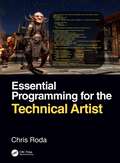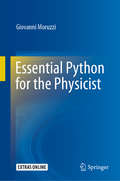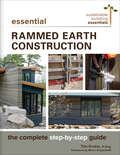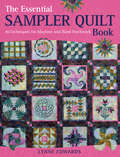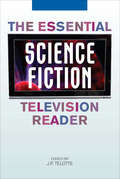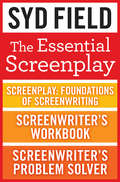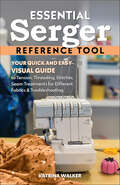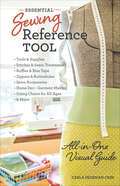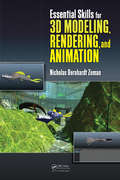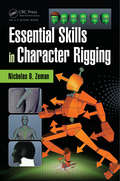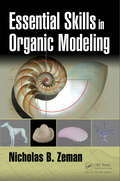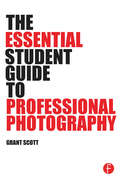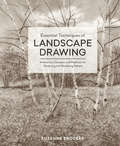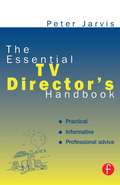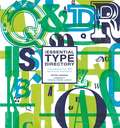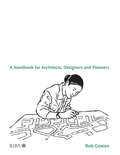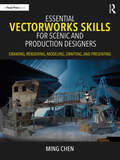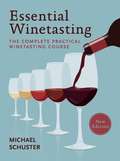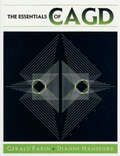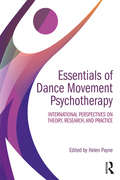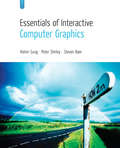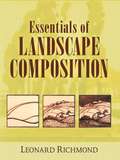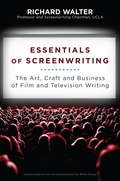- Table View
- List View
Essential Programming for the Technical Artist
by Chris RodaThis book is based on a successful curriculum designed to elevate technical artists with no programming experience up to essential programming competency as quickly as possible. Instead of abstract, theoretical problems, the curriculum employs familiar applications encountered in real production environments to demonstrate each lesson.Written with artists in mind, this book introduces novice programmers to the advantageous world of Python programming with relevant and familiar examples. Any digital artists (not just technical artists) will find this book helpful in assisting with day-to-day production activities.Concentrating upon subjects relevant to the creation of computer graphic assets, this book introduces Python basics, functions, data types, object-oriented programming, exception handling, file processing, graphical user interface creation, PEP 8 standards, and regular expressions. Programming within the SideFX Houdini 3D animation software provides a familiar environment for artists to create and experiment with the covered Python topics.
Essential Python for the Physicist
by Giovanni MoruzziThis book introduces the reader with little or no previous computer-programming experience to the Python programming language of interest for a physicist or a natural-sciences student. The book starts with basic interactive Python in order to acquire an introductory familiarity with the language, than tackle Python scripts (programs) of increasing complexity, that the reader is invited to run on her/his computer. All program listings are discussed in detail, and the reader is invited to experiment on what happens if some code lines are modified. The reader is introduced to Matplotlib graphics for the generation of figures representing data and function plots and, for instance, field lines. Animated function plots are also considered. A chapter is dedicated to the numerical solution of algebraic and transcendental equations, the basic mathematical principles are discussed and the available Python tools for the solution are presented. A further chapter is dedicated to the numerical solution of ordinary differential equations. This is of vital importance for the physicist, since differential equations are at the base of both classical physics (Newton’s equations) and quantum mechanics (Schroedinger’s equation). The shooting method for the numerical solution of ordinary differential equations with boundary conditions at two boundaries is also presented. Python programs for the solution of two quantum-mechanics problems are discussed as examples. Two chapters are dedicated to Tkinter graphics, which gives the user more freedom than Matplotlib, and to Tkinter animation. Programs displaying the animation of physical problems involving the solution of ordinary differential equations (for which in most cases there is no algebraic solution) in real time are presented and discussed. Finally, 3D animation is presented with Vpython.
Essential Rammed Earth Construction: The Complete Step-by-Step Guide (Sustainable Building Essentials)
by Tim Krahn&“All of the essential knowledge for completing a successful rammed earth project. Written by a geo-technical engineer with experience ramming earth.&” —Kelly Hart, author, Essential Earthbag Construction Everything you need to know to build with rammed earth in warm and cold climates. Rammed earth—sand, gravel, and clay or lime/cement binder packed into forms—is a low-energy, high-performance building method, yielding beautiful, sustainable results. It&’s thermally stable and can be insulated, can actively modulate humidity, provides a healthy indoor environment, and allows site materials to be used for major structural and building envelope elements.Essential Rammed Earth Construction covers design, building science, tools, and step-by-step building methods for any climate, with a special emphasis on building in cold climates of the northern US, Canada, and northern Europe. Coverage includes: Overview of earthen building Appropriate use of rammed earth walls Stabilized versus raw rammed earth Design considerations, including structural, insulation, and building envelope details Special considerations for cold and freeze-thaw climates Construction drawings, with step-by-step building instructions Tools and labor covering industrial methods, low-tech techniques, formwork options, mix design, budgets, and schedules Codes, inspections, and permits. This guide is an essential resource for experienced builders, DIY home owners, designers, engineers, and architects. &“A much-needed and science-based update to a North American audience of designers, engineers and builders.&” —Bruce King. P.E., author, The New Carbon Architecture &“ A great book for anyone who wants to deepen their technical knowledge of rammed earth walls systems. It&’s very helpful to have a book on rammed earth that is more focused on engineered rammed earth walls for cold climates.&” —Clifton Schooley, Clifton Schooley & Associates, Rammed Earth Designers and Builders
The Essential Sampler Quilt Book: 40 Techniques for Machine and Hand Patchwork
by Lynne EdwardsDiscover a beautiful celebration of the sampler quilt from one of the world's best-loved quilters. This book offers 40 blocks with full step-by-step instruction and diagrams, perfect for beginners and those quilters wishing to expand their repertoire. The beautiful photographs of sampler quilts plus Lynne Edwards' friendly teaching style make this a reference work you'll treasure. Techniques include machine- and hand-piecing, traditional patchwork and applique.
The Essential Science Fiction Television Reader (Essential Readers in Contemporary Media and Culture)
by J.P. Telotte&“A richly detailed and critically penetrating overview . . . from the plucky adventures of Captain Video to the postmodern paradoxes of The X-Files and Lost.&” —Rob Latham, coeditor of Science Fiction Studies Exploring such hits as The Twilight Zone, Star Trek, Battlestar Galactica, and Lost, among others, The Essential Science Fiction Television Reader illuminates the history, narrative approaches, and themes of the genre. The book discusses science fiction television from its early years, when shows attempted to recreate the allure of science fiction cinema, to its current status as a sophisticated genre with a popularity all its own. J. P. Telotte has assembled a wide-ranging volume rich in theoretical scholarship yet fully accessible to science fiction fans. The book supplies readers with valuable historical context, analyses of essential science fiction series, and an understanding of the key issues in science fiction television.
The Essential Screenplay (3-Book Bundle): Screenplay, Screenwriter's Workbook, and Screenwriter's Problem Solver
by Syd FieldHollywood’s script guru teaches you how to write a screenplay in the ultimate three-volume guide to writing for film—featuring “the ‘bible’ of screenwriting” (The New York Times). This blockbuster ebook bundle includes: SCREENPLAY • THE SCREENWRITER’S WORKBOOK • THE SCREENWRITER’S PROBLEM SOLVER Syd Field was “the most sought-after screenwriting teacher in the world” according to The Hollywood Reporter. His pioneering insights into structure, concept, and character launched innumerable careers. Now in one handy collection, his invaluable expertise is available to aspiring writers and working professionals alike. The Essential Screenplay contains Syd Field’s Screenplay: The Foundations of Screenwriting, the industry standard for script development; The Screenwriter’s Workbook, a hands-on workshop full of practical exercises for creating successful screenplays; and The Screenwriter’s Problem Solver, a guide to identifying and fixing problems in your latest draft. Throughout, you’ll learn: • why the first ten pages of your script are crucially important • how to visually “grab” the reader from page one • what makes great stories work • the basics of writing dialogue • the essentials of creating great characters • how to adapt a novel, a play, or an article for the screen • the three ways to claim legal ownership of your work • tips for allowing your creative self to break free when you hit the “wall” • how to overcome writer’s block forever Featuring expert analysis of popular films including Pulp Fiction, Thelma & Louise, and the Lord of the Rings trilogy, The Essential Screenplay will transform your initial idea into a screenplay that’s destined for success—and maybe even Cannes.
Essential Serger Reference Tool: Your Quick and Easy Visual Guide to Tension, Threading, Stitches, Seam Treatments for Different Fabrics & Troubleshooting
by Katrina WalkerSerge confidently with this pocket-sized reference tool This compact guide contains everything you need to resolve your serging questions, regardless of your experience level. Learn how to thread your serger, choose and use serger stitches, and serge different fabric types. Build your skills with information on differential feed, securing seams, and serging challenging shapes. If you encounter any hiccups, the troubleshooting charts are your trusty companions, helping you troubleshoot tension issues and effortlessly choose the perfect serger stitch for your projects. With this convenient reference tool, you'll be armed with all the information you need to achieve stunning, stress-free results. Get ready to become a serger pro!
Essential Sewing Reference Tool: All-in-One Visual Guide
by Carla Hegeman CrimAll you need to get sewing: supplies, stitches, sizing charts, over 300 photos, and much more. This comprehensive reference is an indispensable guide for anyone who sews (or wants to start). Organized for easy readability and usage, it covers everything you need to know whether you&’re making a home decoration, piece of clothing, or an accessory. Contents include: an extensive overview on tools and materialsstep-by-step instructions on various seams and finishesinformation on zipper installationsize conversion chartsover 300 how-to photographs, and more &“Beginners will be able to follow Crim&’s step-by-step lessons, and experienced sewists will appreciate the quick refreshers on less-common techniques.&”—Library Journal
Essential Skills for 3D Modeling, Rendering, and Animation
by Nicholas Bernhardt ZemanThe Key to Fully Understanding the Basics of a 3D WorldProminently used in games, movies, and on television, 3D graphics are tools of creation used to enhance how material and light come together to manipulate objects in 3D space. A game-changer written for the non-technical mind, Essential Skills for 3D Modeling, Rendering, and Animation examines
Essential Skills in Character Rigging
by Nicholas B. ZemanCharacter rigging is the method with which you create a system for animating a character. A rig is represented by two primary mechanics: the skeleton, consisting of hierarchical rotations to drive the motions, and a skin, or method of deforming the geometry that makes up the character model. Essential Skills in Character Rigging is a beginner's gui
Essential Skills in Organic Modeling
by Nicholas B. ZemanThis is a beginner’s guide to learning and implementing the essential aspects of modeling organic objects and using an organic workflow to model anything. This book gives an aspiring modeler all the tools that they need to know in order to begin creating great models that are efficient and laid out properly for rigging and texturing. The reader will be taken through all the primary techniques and methodologies for making “liveable” creatures for video, film, or games. The reader will also learn the basic physical structure that designates something as organic vs artificial, and how these varying structures can be tackled from a modeling perspective.through a practical, hands-on approach. Features Designed to approach organic modeling in a software-independent manner. Builds fundamental knowledge of 3D digital art from the ground up. Each lesson builds on the previous lesson. Has industry standard knowledge, based on simplicity and efficiency that will work for either production rendering or game development. Defines what organic modeling is and how it works, and why each technique was developed and implemented as it currently stands.
The Essential Student Guide to Professional Photography
by Grant ScottThis essential reference for photography students explains how to become part of the professional community. By defining professional photography today, and exploring what is expected of professional photographers, the book demystifies this often-misunderstood and misjudged career track. The easily accessible text provides readers with valuable information, inspiration, and education on topics including developing your photographic voice, finding your area of specialization, exploring the moving image, building a website, and understanding self-presentation, promotion, legal aspects, and marketing. It also features inspirational projects for students to embark on their education in photography.
Essential Sustainable Home Design: A Complete Guide to Goals, Options, and the Planning Process (Sustainable Building Essentials)
by Chris MagwoodDesign your own sustainable home Many people dream of building a beautiful, environmentally friendly home. But until now there has been no systematic guide to help potential builders work through the complete process of imagining, planning, designing, and building their ideal, sustainable home. Essential Sustainable Home Design walks potential homebuilders through the process starting with key concepts, principles, and a project vision that will guide the house to completion.Coverage includes:How to clarify your ideas and create a practical pathway to achieving your dreamA criteria matrix to guide design, material, and systems decisionsCreating a strong, integrated design team and working with professionals and code officials to keep the project on track from start to finish.Key building science concepts that make for a high-performance, durable buildingPrimer on building logistics, material sourcing, and protocols to ensure that the initial vision for the project comes to fruition.One-page summaries and ratings of popular sustainable building materials and system options.Ideal for owner-builders and sustainable building contractors working with clients aiming to design and build a sustainable home. Chris Magwood has designed and built some of the most innovative, sustainable buildings in North America, including the first off-grid, straw bale home in Ontario. He is co-founder and director the Endeavour Centre for Innovative Building and Living and co-editor of the Sustainable Building Essentials series. Chris is the author of Essential Prefab Straw Bale Construction, Essential Hempcrete Construction, Straw Bale Details, More Straw Bale Building , and Making Better Buildings .
Essential Techniques of Landscape Drawing: Master the Concepts and Methods for Observing and Rendering Nature
by Suzanne BrookerThis beginner's guide to drawing in graphite pencil uses step-by-step exercises to teach fundamental methods for rendering all aspects of the natural landscape, with additional lessons on using charcoal, colored pencil, pastel, and other media.Following in the footsteps of author, artist, and art instructor Suzanne Brooker's previous title The Elements of Landscape Oil Painting, this book pairs the most universally-pursued topic for artists (drawing) with the popular subject matter of the natural landscape. Brooker breaks down landscapes into their various elements--including the earth, water, air, and trees--to convey how the fundamentals of drawing are applied to capture each aspect. Using the graphite pencil as her baseline instrument, Brooker provides you with step-by-step lessons that help you improve your rendering skills and re-create the beauty of the world outdoors. Examples from art history and contemporary masters supplement these lessons. The end result is a drawing instruction book that provides artists with everything they need to render landscapes no matter their skill level.
The Essential Theatre
by Oscar G. Brockett Robert J. Ball John Fleming Andrew CarlsonThe Eighth Edition of THE ESSENTIAL THEATRE will help you get your students excited about theatre. The combined authorship of an authoritative theatre historian and his former student, an active theatre historian himself, make this the book perfect for your introductory theatre course. In the 35 years since it was first published, THE ESSENTIAL THEATRE has established a reputation as one of the most comprehensive, authoritative surveys of the theatre in academia. Now in a new full color format with many representations of current and classic performances, this text will encourage your students to become active theatergoers and fans. THE ESSENTIAL THEATRE works in tandem with its companion anthology, PLAYS FOR THEATRE. The scripts in PLAYS serve as a foundation for discussion of the various types of theatrical experience explored in the text.
The Essential TV Director's Handbook
by Peter JarvisThe Essential TV Director's Handbook is written by an ex-BBC trainer with a great deal of experience in the world of television. It describes step-by-step how to prepare and direct every familiar type of common programme format including interviews, discussions, reportage, music and dramatisations shot either on location or in the multi-camera studio. It is the essential reference handbook for any director confronted by a new programme format or the challenge of an unfamiliar technology. An appendix suggests plans for the most commonly encountered studio situations. Television culture has been changing fast. Whilst technology races on at a frightening pace programme budgets have been slashed, job descriptions widened as more people have to `multi-skill', and traditional routes of entry have become increasingly difficult to find, with diminishing access to professional training.Yet the skills and practical knowledge required to make top quality programmes remain unaltered. `The Essential .... Handbook' series offers a range of no nonsense guides to the craft of TV programme making based on tried and tested tricks of the trade. Each book is written in an entertaining and informative way providing only the essential `need to know' information for beginner broadcasting professionals and students alike.The Essential TV Director's Handbook is written by an ex-BBC trainer with a great deal of experience in the world of television. It describes step-by-step how to prepare and direct every familiar type of common programme format including interviews, discussions, reportage, music and dramatisations shot either on location or in the multi-camera studio. It is the essential reference handbook for any director confronted by a new programme format or the challenge of an unfamiliar technology. An appendix suggests plans for the most commonly encountered studio situations.Peter Jarvis is a freelance producer and director of thirty years practical experience. He is Director of Television Training International and was for eight years Senior Production Instructor with BBC's Television Training Department.
The Essential Type Directory: A Sourcebook of Over 1,800 Typefaces and Their Histories
by Peter DawsonThe most comprehensive, practical, and beautiful directory of type, organized by type category-Serif, San Serif, Display, and Scrip-and covering all styles throughout history. The Essential Type Directory offers 1,800 examples of the best in type design, spanning almost 600 years of design history. From classics such as Garamond, Baskerville, Futura, and Helvetica, to more idiosyncratic recent creations such as Gotham and Filosofia, The Essential Type Directory features illuminating profiles of the most important and influential typefaces ever created. Organized by type category-Serif, Sans Serif, Display, and Script-each typeface is presented in uppercase and lowercase alphabetical letters, along with numbers, key punctuation marks, and symbols. This comprehensive guide also features profiles and interviews with leading designers and type foundries, as well as inspirational examples of graphic designs using specific typefaces.
Essential Urban Design: A Handbook for Architects, Designers and Planners
by Rob CowanShaping our cities, streets and public spaces, urban design informs the places we live. It is a complex multi-disciplinary process, requiring the input of a wide variety of stakeholders and design and construction professionals. Each urban project invariably throws up a new set of problems and strategic decisions for the design team. This guide distils the essential information required for the expert direction of the day-to-day work of urban design, from strategic design to masterplanning through to character assessment and collaboration. Compact and accessible with over 250 hand-drawn figures and plans, it's the perfect everyday companion for junior practitioners and experienced heads alike across the built environment.
Essential Vectorworks Skills for Scenic and Production Designers: Drawing, Rendering, Modeling, Drafting, and Presenting
by Ming ChenEssential Vectorworks Skills for Scenic and Production Designers is an accessible textbook that covers the digital skills of 2D drawing, 3D modeling, rendering, drafting, and design presentation, providing aspiring designers with an invaluable toolkit to quickly and efficiently hone their craft.Modeled after learner-centered teaching practice and based on USITT drafting standards, this book is structured around six carefully selected core projects. It introduces key terms and commands, tools, techniques, and procedures for drawing, modeling, rendering, drafting, and design presentation with Vectorworks. Each chapter begins with key commands and a set of learning objectives that will be explored. The design exercises and projects that follow invite the reader’s active participation in the learning process. Along with step-by-step instructions, 240 illustrations (including student work samples), and three insightful interviews with professional designers, this book also contains open-ended projects that encourage the reader to explore new ways of scenographic expression and creatively apply commands and techniques to solve example design problems.This textbook is for use in scenic design, drafting, model making, and rendering courses in university theatre and media programs, and may be of interest to emerging professional scenic designers or scenographers for theatre, opera, and concert performances, production designers or art directors in film and television industries, themed exhibition designers, and theme park designers.Essential Vectorworks Skills for Scenic and Production Designers includes access to a wealth of online resources, including 15 videos with step-by-step instruction, six files of vwx or PDF formats for additional exercises and projects, and a video of student work samples.
Essential Winetasting: The Complete Practical Winetasting Course
by Michael SchusterAn authoritative and inspirational winetasting course, from one of the world's leading wine educators. 'Explains the mechanics of taste and tasting better than any book I've seen.' - Richard Ehrlich, Independent on Sunday Learn how to taste wine, with one of the world's leading wine educators. This book offers a particularly clear and precise means of teaching yourself how to taste and how to get more out of your wine, whatever your level. All the major grape varieties are explored, and their key characteristics in different regions. Ten practical tastings then cover core tasting techniques. Do you want to explore Dry Whites, for example, looking at 'Old World' versus 'New World' Sauvignon Blancs? Or investigate 'terroir' in a range of Bordeaux wines? Additional information on subjects such as Wines and Age and the impact of climate change complete the picture, making this book a powerful tool for understanding and appreciating wine at all levels.
The Essentials of CAGD
by Gerald Farin Dianne HansfordPutting the G into CAGD, the authors provide a much-needed practical and basic introduction to computer-aided geometric design. This book will help readers understand and use the elements of computer-aided geometric design, curves and surfaces, without the mathematical baggage that is necessary only for more advanced work. Though only minimal backg
Essentials of Dance Movement Psychotherapy: International Perspectives on Theory, Research, and Practice
by Helen PayneEssentials of Dance Movement Psychotherapy contributes to the global interest in embodiment approaches to psychotherapy and to the field of dance movement psychotherapy specifically. It includes recent research, innovative theories and case studies of practice providing an inclusive overview of this ever growing field. As well as original UK contributions, offerings from other nations are incorporated, making it more accessible to the dance movement psychotherapy community of practice worldwide. Helen Payne brings together well-known, experienced global experts along with rising stars from the field to offer the reader a valuable insight into the theory, research and practice of dance movement psychotherapy. The contributions reflect the breadth of developing approaches, covering subjects including: • combining dance movement psychotherapy with music therapy; • trauma and dance movement psychotherapy; • the neuroscience of dance movement psychotherapy; • the use of touch in dance movement psychotherapy; • dance movement psychotherapy and autism; • relational dance movement psychotherapy. Essentials of Dance Movement Psychotherapy will be a treasured source for anyone wishing to learn more about the psychotherapeutic use of creative movement and dance. It will be of great value to students and practitioners in the arts therapies, psychotherapy, counselling and other health and social care professions.
Essentials of Interactive Computer Graphics: Concepts and Implementation
by Kelvin Sung Peter Shirley Steven BaerThis undergraduate-level computer graphics text provides the reader with conceptual and practical insights into how to approach building a majority of the interactive graphics applications they encounter daily. As each topic is introduced, students are guided in developing a software library that will support fast prototyping of moderately complex
Essentials of Landscape Composition
by Leonard RichmondAnyone who has mastered the art of writing can learn to draw, according to this accomplished artist and author of several fine art books. Confident that most people have the ability to express themselves artistically once they have acquired the right techniques, Richmond offers his tried-and-true methods of drawing and composition in this easy-to-follow guide."The short road to success" begins with a brush. Richmond advises novices to forego the use of a pencil, since it demands a higher degree of accuracy than the beginner possesses. When a brush is used, the ink glides over the paper easily and is more likely to bring desired results. Starting with simple lines and curves, then moving on to various elements--from clouds and trees to castles and cottages--Richmond offers exercises to train the eyes and hand to work together. In step-by-step pictorial sequences, he effectively illustrates how to construct a successful landscape, offers tips on perspective--and even uses several great works of art for lessons in composition. Invaluable for students and teachers, this guide will help artists at every level bring landscapes to life.
Essentials of Screenwriting
by Richard WalterHollywood's premier teacher of screenwriting shares the secrets of writing and selling successful screenplays Anyone fortunate enough to win a seat in Professor Richard Walter's legendary class at UCLA film school can be confident their career has just taken a quantum leap forward. His students have written more than ten projects for Steven Spielberg alone, plus hundreds of other Hollywood blockbusters and prestigious indie productions, including two recent Oscar winners for best original screenplay-Milk (2008) and Sideways (2006). In this updated edition, Walter integrates his highly coveted lessons and principles from Screenwriting with material from his companion text, The Whole Picture, and includes new advice on how to turn a raw idea into a great movie or TV script-and sell it. There is never a shortage of aspiring screenwriters, and this book is their bible.
